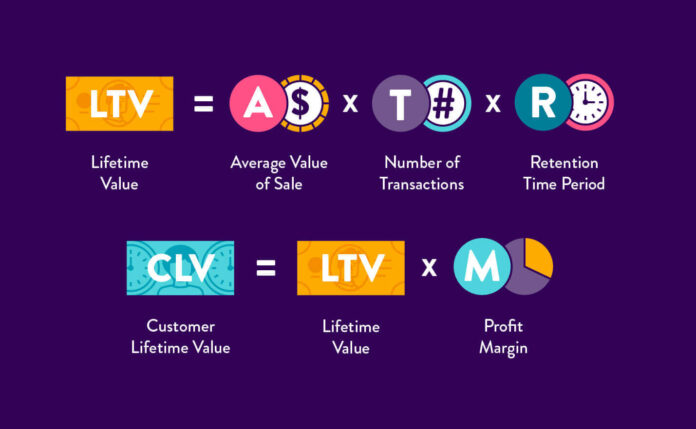The translation of the English term “lifetime value” or LVT is “lifetime value” and can be easily understood when we put it in the correct context. This metric estimates the liquid profit of a client’s life within the company.
What is the value of a customer?
At first glance, this question may seem impossible to answer.
After all, no business survives without customers, and only the entrepreneur knows the effort required to get each one.
But, digital tools changed the way business is done, and one reason is the ability to measure almost everything in a marketing and sales strategy.
Among the elements that you can (and should) know well, is lifetime value – which answers the question that started this article.
In practice, this metric can teach a lot about various aspects of the company and help you in the way you organize yourself with the aim of guaranteeing a healthier future for your business.
Do you want to know more information about lifetime value and how to use this indicator on a daily basis to make better decisions? Then join us!
What is lifetime value?
The translation of the English term “lifetime value” or LVT is lifetime value and can be easily understood when we put it in the proper context. This metric estimates the liquid profit of life of a client within the company.
The lifetime value of a customer refers to how much money he will offer to your company during the entire time of relationship with your brand.
Wait to?
Well, let’s give an example to make it easier to understand the question:
Think one of your customers made four purchases in two years, and then never bought anything again.
Each purchase had a different value.
- The first was $ 25.00;
- The second for $ 100.00;
- The third for $ 120.00;
- And the last one for $ 80.00.
Thus, you could say that the lifetime value, or LTV, of that person was $ 325.00, which is the sum of all the values spent by him during the entire period that he was your client.
Naturally, the idea of this indicator is not to make a separate account for each client.
That would be quite time consuming and inefficient.
The objective is to analyze all clients, in general, and find the midpoint of cost values and residence time.
Thereafter, adjustments will be made, both to increase value and to make customers stay longer before leaving the product or service and looking for another alternative.
Why is this indicator essential for the health of your business?
You don’t need to think hard to understand how LTV is essential for the health of your company.
Knowing precisely how much money, approximately, customers spend and for how long they use your product or service can help:
- Define the maximum marketing budget to avoid spending too much on acquisition and losing money in the long term;
- Know how much of a recipe you can expect for the next months, based on the sales history and the LTV;
- Find specific flaws that lead customers to withdraw from the service early; and
- Find underutilized opportunities to improve acquisition and retention.
In other words, calculating and monitoring lifetime value is essential to make better management and marketing decisions.
How to calculate lifetime value without complications?
You should have already noticed, by the example indicated, that it is not difficult to calculate the lifetime value of the clients.
But, to facilitate, there is a basic formula so that no one is wrong when making the famous account.
It’s just following the model:
LTV = (average ticket x average purchase per customer per year) x average relationship time
We are going to put some real data to make it easier to understand the account:
Let’s assume that the value spent, approximately, by your customers all month is $ 400.00.
The value is payment per month, so the average transaction per customer throughout the year will be 12 (1 per month).
Finally, let’s say that the average relationship time (from purchase to the end of the relationship) is 3 years.
The formula with these numbers would leave the calculation like this:
LTV = 400 (average ticket) x 12 (number of purchases per year) x 3 (duration of the contract)
LTV = ($ 400.00 X 12) X 3
LTV = $ 4.8 thousand x 3
LTV = $ 14.4 thousand
In this case, the lifetime value of your customers would be $ 14.4 thousand.
This would be the total value invested by a client in your company.
If the residence time was less than a year, it would be just multiplying the average ticket by the total number of purchases.
For example:
If the contract time here were 10 months, the account would be only:
LTV = $ 400.00 X 10
LTV = $ 4 thousand
Which indicators are important for lifetime value?
LTV is a powerful indicator, but, like any metric, it has to be analyzed in context.
This means comparing the collected data with other relevant metrics.
This comparison helps to complete the breakthrough that shows the real and complete situation of the business, that is, it shows what is working well and what needs more attention to improve.
Check out some more important metrics to evaluate along with lifetime value:
Churn Rate
The churn rate measures how many people cancel the product each month.
The higher that indicator is, the worse your LTV will be.
Therefore, it is important to evaluate churn in isolation.
That will help you see if your churn rate is too high and find ways to increase customer satisfaction and retention.
Customer acquisition cost (CAC)
The acquisition cost is perhaps the most important metric to compare the LTV, it indicates how much the sales and marketing team spends to close every sale.
If the value of the CAC (which is generally an expense before the sale occurs) is very close to or even greater than your lifetime value (value that will be received over the years), the financial health of the business is in serious danger. .
So the rule is always to keep the CAC well lower than the LTV.
Average ticket
The average ticket is also taken into consideration to determine the LTV.
Thus, evaluating it in isolation is of great help in finding opportunities to increase the value received from the customer base.
As the value of the average ticket goes up, the value of the lifetime value also goes up, which is great for the entire business.
How to increase the LTV of your business?
The goal is always to ensure that customers maintain a good relationship with your brand for as long as possible and that the value invested by them increases over time.
How to complete this double mission?
One thing is certain:
There are no short paths, just techniques and good practices that you need to follow.
The sooner you start using them, the faster you will see the reward.
If you perform the four actions that we will explain below, you will have excellent results with the LTV and with the other metrics we talked about earlier:
Invest in content marketing
The marketing content s , when well executed, has the power to help attract many customers for your business, no matter what size or market segment where you act.
There are many things at stake in a content strategy such as blogging and SEO investment.
But the most important thing is to plan well, execute accurately and be patient.
Consider customer loyalty as something very serious and important
Customer loyalty is a continuous effort and must be part of the business culture.
If customers are not everyone’s priority, some part of the process will show little importance – and the churn will increase.
Quality care throughout the business process and a real after-sales strategy make a lot of difference. Even, it can be said that it makes as much difference as improvements in the product or competitive prices.
Implement customer success
The success of the client is not restricted to attention, since it requires importance to the smallest details to guarantee that the client always has the best results with what he acquired.
Basically, the role of the customer success manager is to ensure that all the promised value in the sale is delivered, apart from identifying potential problems and avoiding them before they happen.
Eyes wide open in digital transformation
The digital transformation provided important advances and continues its development at the most diverse levels of society.
Pay attention to the changes that this phenomenon has had and analyze how it can impact the market segment where you operate.
It pays to be willing to risk and innovate with technology solutions that will enrich the customer experience and generate more value without increasing costs for the customer.
Whoever does this today will reap excellent fruits.
Since lifetime value is not just an effort for the present – but also for the future – this practice is essential.
Lifetime value is crucial to the health of any business and is not a difficult number to measure.
Don’t forget to keep track of the indicator constantly and compare the data with other metrics.
This will allow you to have a broader vision, highly necessary to achieve better results.













